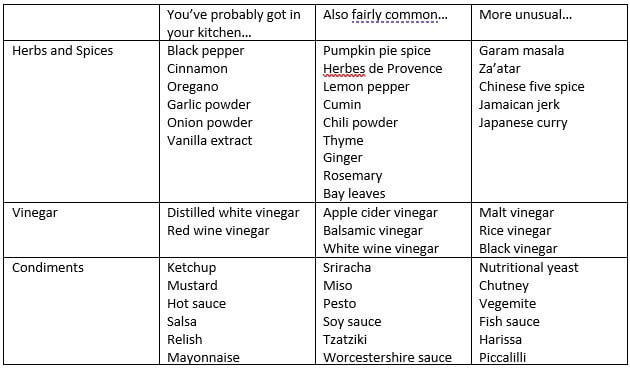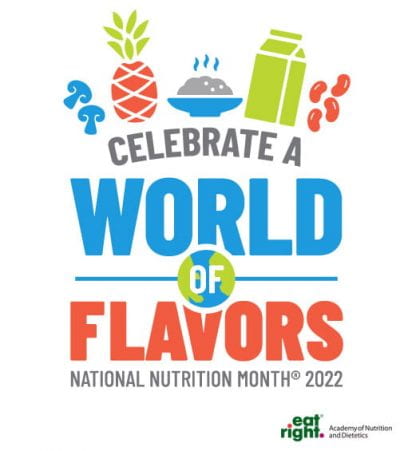March is National Nutrition Month ®. This annual campaign was created by the Academy of Nutrition and Dietetics in 1973 as National Nutrition Week and was launched with a presidential proclamation, TV and radio public service announcements, news releases and bumper stickers—all featuring the theme “Invest in Yourself—Buy Nutrition.” In 1978, Nutribird—with a body shaped like lettuce and a beak like a carrot—was introduced. Other persuasive themes that have been used over the years include: 1985 – Food: It even sounds nutritious. 1994 – Nutrition fuels fitness. 2002 – Start today for a healthy tomorrow. 2017 – Put your best fork forward. And this year—Celebrate a world of flavors.

Our World of Flavors
We are lucky in our area to have access to foods produced locally to internationally. Some local farms grow 40 different kinds of vegetables, a local orchard might offer 15 varieties of apples, and the supermarket brings us the tastes of tropical climates and faraway lands. There are many fresh choices year-round: if it’s not in season locally, it’s probably in season somewhere else in the world. Canned, frozen, and dried options are also readily available, and sometimes more wallet friendly. They’re nutritious choices along with fresh—but watch for too much added salt and sugar in those lightly processed foods.
All this together gives us the possibility of the comfort of familiar choices, but also the chance to try something new. Thirty years ago, avocados and hummus were not common in kitchens across the U.S.—who knows what goodies are waiting for their time to shine? In the meantime, take a look at our lists here to check in with your old favorites and maybe discover a new favorite.



You can probably guess which of these is starfruit, even if you’ve never tasted it. Golden beets have a sweeter, less “earthy” flavor than their more common red counterparts. USDA Media by Lance Cheung. Sorghum (also known as milo) is the third-largest cereal grain in the United States. Often used in livestock feed, it’s also a nutritious, gluten free, whole grain option for humans. USDA Photo by Lance Cheung.

Even More to Explore
Using herbs, spices, and vinegars for flavor can help to keep our sodium intake down while boosting the delight of meal time. When reaching for condiments—which are often high in salt (and sometimes fat and sugar!)—try to find low-sodium versions, or keep to a recommended serving size.

Pesto is easy to make at home. Traditional recipes use basil, but try other leafy greens like spinach, chard, or kale. "Got Pesto!" by cogdogblog is licensed under CC0 1.0

No More Boring Chicken
With a world of flavors to explore, if you’re bored with chicken, be bored no more! Here are some ideas to jazz up chicken night at your home. Pre-made spice blends can be found for many of these, though you might have the individual spices in your spice rack to make your own combinations.

- Chicken Shawarma – A Middle Eastern dish that features black pepper, cumin, garlic, coriander, paprika, and sometimes other spices.
- Southwest Chicken – Think fajitas, with garlic powder, cumin, and chili powder.
- Sweet and Sour Chicken – The sweet can be from pineapple juice instead of sugar, the sour is usually vinegar, and they may be combined with soy sauce, ginger, tomato paste, and onion.
- Jerk Chicken – A spicy Caribbean dish with the flavors of hot peppers, allspice, ginger, cinnamon, and thyme, among others.
- BBQ Chicken – A creative version of BBQ sauce from the American Heart Association calls for unsweetened apple sauce, sugar free peach preserves, and apple cider vinegar, along with meat (they used pork) seasoned by thyme, garlic, chili powder, paprika, and black pepper.
- Sriracha Glazed Chicken – The heat from this spicy Asian sauce can be tamed a bit by adding the sweetness of fruit to your dish or drinking some low-fat milk along with it.
- Chicken Satay – The sauce that tops this traditional skewered Thai dish often features peanut butter in addition to garlic, fish sauce, and soy sauce.
NEED A RECIPE?
Check out the healthy recipes at sources like the CCE Schoharie and Otsego Counties website, MyPlate.gov, and the American Heart Association.
************************************
Is your favorite missing from our list? We’d love to hear what it is! Reach out to our nutrition educators with comments, questions, or to let us know about your interest in our free nutrition/cooking classes: Michelle Leveski, mml39@cornell.edu, 518-234-4303 ext. 115, or Kimberly Ferstler, kmf239@cornell.edu, 518-234-4303 ext. 120

